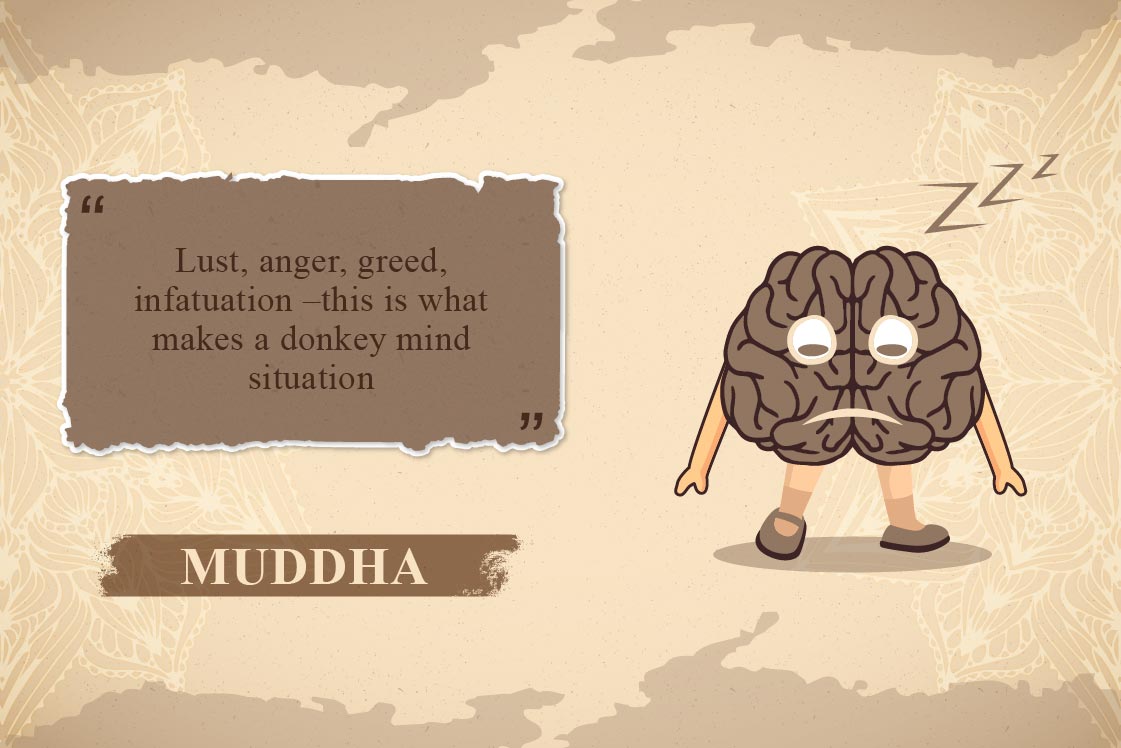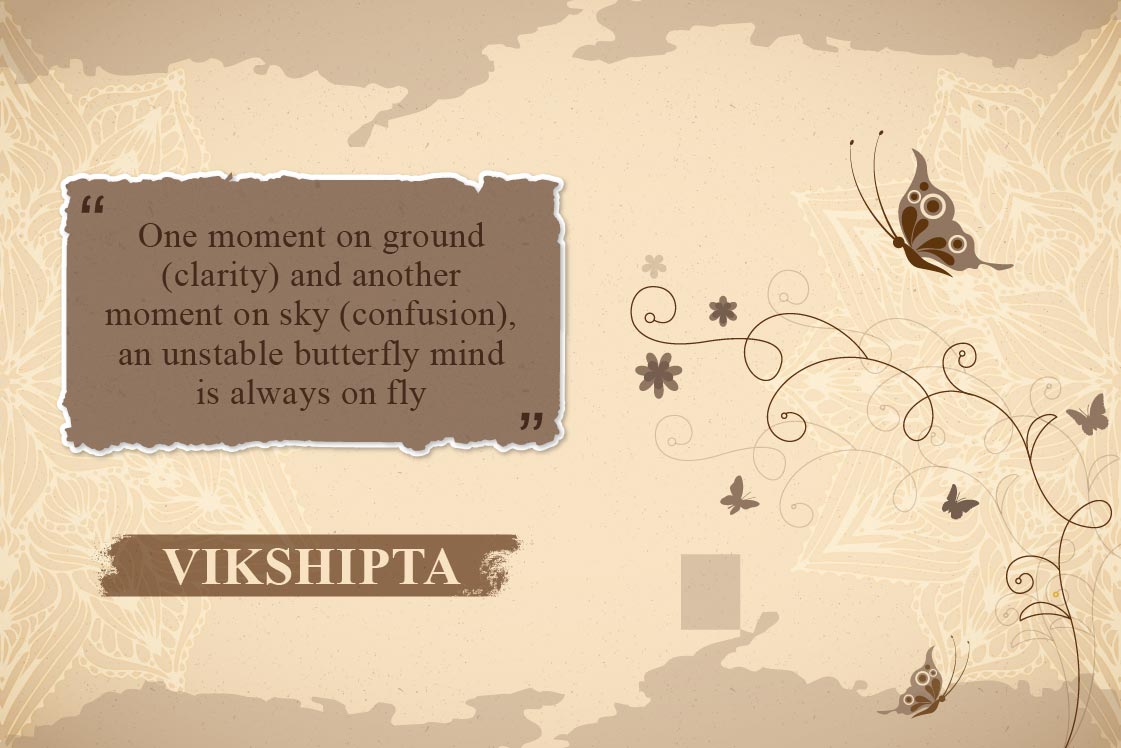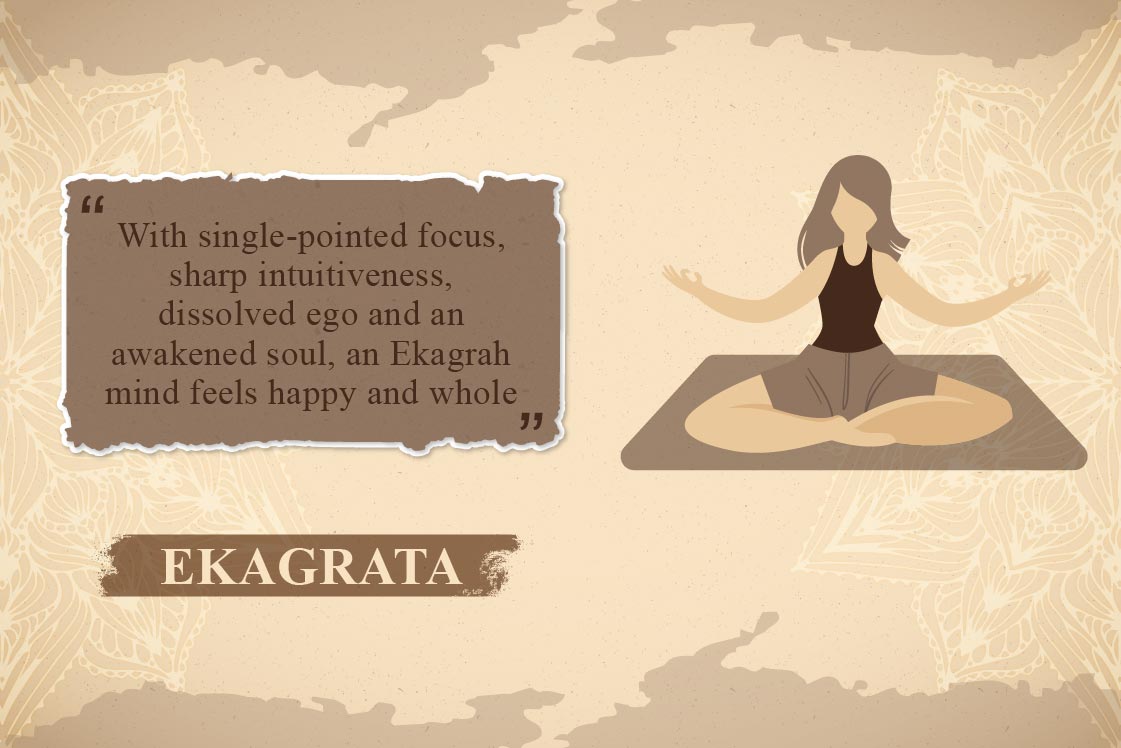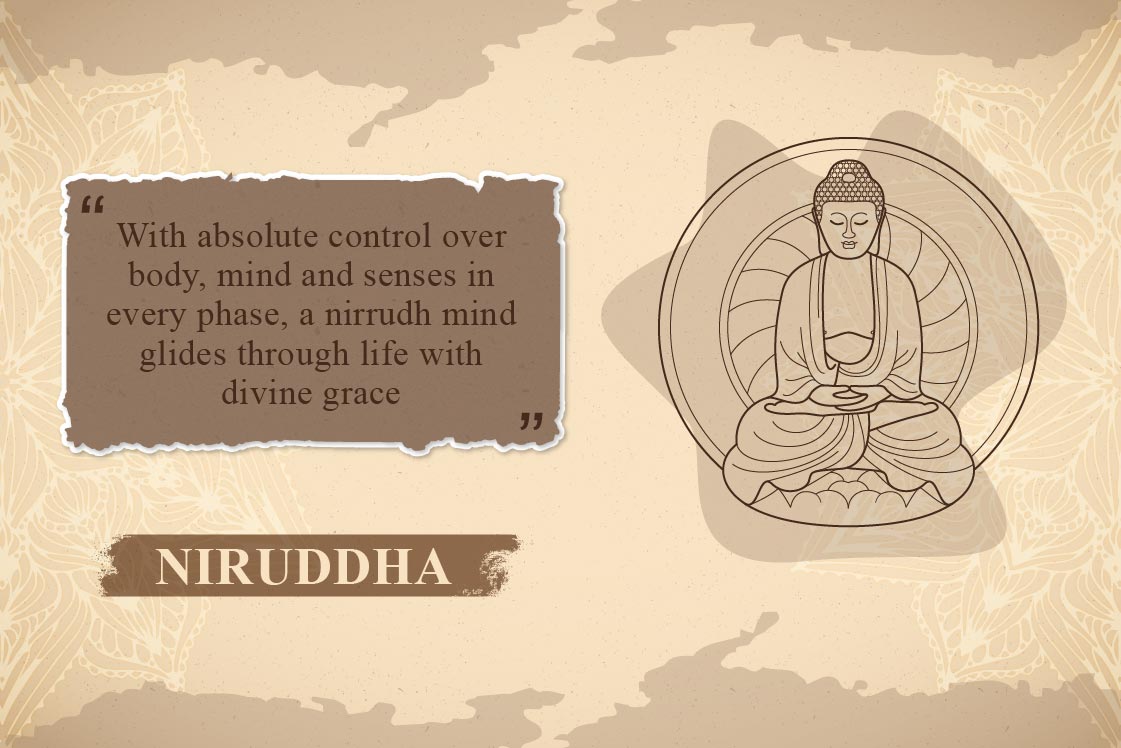Yoga is the cessation of the movements of the mind.योग: चित्त-वृत्ति निरोध: (In Sanskrit ) ~ Patanjali Yoga Sutra 1.2
With this phrase, Maharishi Patanjali, the author of a famous yogic text ‘Yoga Sutra’ cleared the whole purpose of yoga in just 3 words.
Understanding the Sutra:
Chitta, often referred to as the mind, is constantly fluctuating. These fluctuations reflect the imbalance of the three Gunas – Sattva (purity), Rajas (activity), and Tamas (dullness) – which manifest as Vrittis. Thus, the purpose of yoga is the cessation (Nirodha) of these fluctuations (Vrittis) of the mind (Chitta). This leads to a state of Samadhi, where the mind remains calm and undisturbed even in challenging circumstances.
To achieve absolute calmness and balance, one must understand the various states of the human mind.
5 States of Mind
In Vyasa’s commentary on Yoga Sutra stanza 1.1, he states that yoga is Samadhi (contemplation). Samadhi, a key characteristic of Chitta, pervades all five states of the mind, known as the 5 Bhumi of Chitta. These states are:
The 5 states of mind in which Samadhi lies are:
Kshipta – Chaotic or most fickle state of mind
Mudha – Dull or Lazy state of mind
Vikshipta – Partially focused mind
Ekagra – One-pointed mind
Niruddha – Fully absorbed mind
Now the point should be noted down here is that The Samadhi in the first 3 states of mind is not part of ‘Yoga Samadhi’ because their continuity is very unsteadiness or in those states, mind changes frequently. Though, Samadhi lies there for a tiny fraction.
Yoga is actually when Samadhi lies in the last two states of mind (Ekagrata and Niruddha).
Indeed, Understanding the characteristics of each state of mind helps in achieving the ‘Yoga Samadhi’.
1. Kshipta – The Monkey Mind

Kshipta or scattered is the lowest and most common state of the mind which manifests during waking hours. This state is dominated by the “rajas” guna because of the most time in waking hours involved in some physical or mental activity.
In this mental state, a person alternates between extreme states –love and hate, like and dislike, pleasure and pain, enthusiasm and boredom. The mind is totally restless as it is always jumping from one thought to another. There is a lack of clarity in vision and you might feel anxious, confused, unable to understand and relate peacefully with others in your relationships. Here, the mind lacks necessary cognitive abilities which reflect in the form of poor decision-making skills in the day to day situations of life.
Here in this state, managing even the mundane day to day responsibilities becomes a challenge for the wandering mind. This has become a common state in today’s stressful times. The mind is extremely restless as it is always jumping from one thought to another. In monkey mind state, you are not able to conduct your daily life with ease and calm.
Symptoms of Ksipta State
1. Lack of decision-making ability2. Restlessness3. Confusion and absolute lack of clarity4. Anxiety
How To Handle Monkey Mind
Yoga helps you to understand that you (the knower) are not your thoughts and hence, you are able to observe your thoughts and still not get identified with them. By being a witness, you can manage and prioritize your attention only towards healthy, important and constructive thoughts patterns while letting go of the undesired ones.
For example, you can identify and drop unhealthy patterns like waking up late, wrong food habits, negative self-talk, complaining. Similarly, you can consciously inculcate desired life patterns into your life. By doing this, you are giving clear directions to your mind so that it stops wandering and focuses only on what is required at the moment. In this way, Yoga can help you to be present at the moment with greater attention and ease.
2. Mudha – The Donkey mind

The Mudha or Dull state of mind is dominated by the ‘tamas’ guna in which the mind is sluggish, sleepy and lacking vitality. Due to the sluggish nature of mind, a lack the energy observed in this state to deal with subtle and deep issues of life.
Most of us usually oscillate between Kshipta and Mudha states during the waking hours. We are impelled towards an object of sense through rajas nature of our behavior. However, if the desired result is denied to us or greater effort is required, the dull mind due to lack of concentration find excuses and entraps us into a feeling of dissatisfaction. In this case, tamas guna can drive us into a state of sadness or depression.
In nutshell, Mudha state of mind is when you are not able to hear your inner voice and communicate to your true self.
Symptoms of Mudha State
Lack of energy and vitality
Poor concentration
Distorted connection with the inner self
Depression /Sadness
How To Handle Donkey Mind
This mostly happens in cases where you have to adapt to a totally new life situation and you lose a sense of identity in the newfound space.
To handle mind in this state, drop all your thoughts, and reconnect to your inner world through Yoga and meditation so that you are able to find your ultimate true self which will stay with you in all situations of life. Yoga helps you to stay connected with spiritual self so that you can move through changing life situations with newfound ease.
3. Vikspita – The Butterfly mind

There are moments in life where sattva guna starts to dominate and the mind can focus and concentrate. We feel balanced, happy and clear in all spheres and life appears to be a beautiful flow. Then, as some difficult and painful situations crop up, our mind gets distracted and we fall back into old patterns. The mind is pulled away from Sattva back to rajas or tamas.
This is the Vikspita state where the mind is alternating between moments of clarity and distraction. In this state, you are not fully in control of your thoughts. However, you are able to be aware of the subtleties of life.
For example, in our Yoga practice when are fully absorbed into meditation, we experience moments of absolute calmness and focus. However, when there is the slightest distraction, we lose our focus. We get distracted and blame the external factors for creating a disturbance. We blame the environment and not our perception. In this situation, consistent practice of Yoga helps you to understand that we can never change the external environment and enables you to handle life with equanimity in all situations.
Symptoms of Vikspita State
Calm mind, however, gets easily distracted
Better concentration
Mind is sometimes stable and other times confused.
How To Handle Butterfly Mind
By focusing more on meditation, you will be able to hold on to the periods of calmness and make them a way of your life. Regular meditation practice will also instill a better sense of clarity so that you do not get easily distracted by difficulties and handle life with equanimity
4. Ekagra – One-pointed mind

All inner noise has calmed down and the mind is now peaceful, aware and ready for focus. In Ekagra state of mind, one can bring their complete attention at one point, without affecting by any external agencies as long as a person wants to hold. It results, dies down of all confusion and anxiety of the person.
In yogic sense, what you perceive of an object is the state of Samadhi is the only “direct perception” .What is perceived through five senses is impaired and incomplete perception, because of the imperfections of senses, mind, and buddhi which are under the influence of the negative ego.
Vyasa in his commentary on yoga sutra said Ekagra or one-pointed mind erase all the afflictions which cause suffering and pull out a person from the bondage of karma.
Symptoms of Ekagra Mind
Better focus
More awareness and clarity
Thinned ego
Awakening of intuition
Mind In Ekagra State
Mind in this state is said to be in the yoga or one can say, it’s the point where one’s yogic journey has started in real sense.
Through this state of mind, you found a single-pointed focus in life which will help you to filter through your experiences, dissolve your ego, awaken your intuitiveness and sense things beyond the five senses. You will feel absolutely in control of your thoughts and actions.
You need to remain consistent in your Yoga practice in order to maintain this state.
5. Niruddha – fully-focused mind

After passing through the state of Ekgrah (one-pointedness), one is able to able hold on to a single point of focus. Here, the attention is fully arrested and concentrated on one point.
At this stage, no old or new impressions can distract the mind from point of focus and complete stillness is reached. One is able to glide through life with utmost grace. There is no reaction to life’s ever-changing situations. One can soar to even higher mental states in his Yogic journey from this point.
In the state of Nirodha, the mind is now fully under the control of the yogi and all the fluctuations come under the direct control of intellect (sattvic buddhi) as opposed to being controlled by ego. When the Yogi sustains in the state of Niruddha for long periods, the mind reaches a state of equilibrium of the trigunas which leads to liberation (Kaivalya)
Symptoms
Single-pointed focus
Stable mind
Grace in the overall aura
The complete stillness of thoughts
Mind in Niruddha State
Though Niruddha state of mind is the ultimate goal of yoga (Yoga Chitta Vritti Nirodha), you need to continue your yoga practice and constantly analyze your mental state. Also, find new ways to maintain and grow in your consciousness.
Conclusion
In our day to day life, most of us can be seen in the first three states of mind. These 3 states of mind are responsible for abiding us with the external world.
The Kishipta mind is too restless to maintain concentration and balance.
The Mudha mind lacks the energy to make an effort to focus.
The Vikshipta mind lacks consistency and is unable to maintain focus.
There will be moments of concentration and balance and at other times, the Yogi gets distracted and trapped into old habits. However, Vikshipta mind can maintain focus through determination, discipline and consistent practice.
Last 2 states of mind (Ekagra and Niruddha) helps a yogi to internalize the awareness. Hence, it helps in achieving higher states of concentration.
The above classification of mind states helps us to understand our own mental state so that we can grow in our levels of consciousness in our spiritual or material pursuits.




